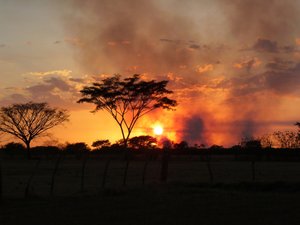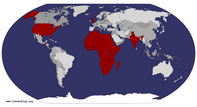Advertisement
Published: January 30th 2017

 Sunset at Kico's
Sunset at Kico's
Fires burn in the cane fields THE ALCHEMISTS OF THIENSVILLE-MEQUON
by Dennis Cunningham
Olieveros, Guatemala
You may not be aware of this, but the Thiensville-Mequon Rotary Club, which meets Tuesdays at noon, performs powerful magic on a regular basis. They will almost certainly deny it. They will tell you that they are, by and large, a secular organization. I know better, and I plan to expose them.
In mid January of this year I personally witnessed the creation, and subsequent disappearance, of an entire medical clinic in Guatemala. It happened somewhere between no-where and no-thing, in the southern part of the country, where mountains dissolve into blazingly hot flatland and cane fields burn. The Rotary Club performs this magic, under the auspices of the Guatemalan Medical Resource Project (GMRP) although they would be reticent to admit to their powers.
An advance team of shamans arrives in the village of Oliveros, after traveling for four hours on a stiff-springed yellow school bus from Guatemala City. The penultimate leg crosses 50 miles of bad road, and the ultimate, 10 miles over disc-bulging washboard gravel.
Enrique “Kico” Gandara, a Rotarian from the Madison, originally hails from this

 Triage
Triage
Jeannine Desautels from Madison screens a patient at the cliniclittle village of Oliveros, where most people escape the furnace of the sun under their palm leaf roofs. They cook on simple gas stoves or on open fires, and work in the cane fields, mango groves, or the pepper farms. The basic tool is the machete. Kico knows the pressing need that exists in this remote village, where health care is at a premium at best, and at its worst, non-existent. An amazing storyteller, Kico has been instrumental in creating this phenomenon. I arrive with the main team of volunteers the evening before the clinic opens. We stay on Kico’s family ranch in simple cabanas, a short dusty walk through the pastures to the clinic.
On the first morning we rise at 6:00 for an open-air breakfast. There are red slices of watermelon, green melon, and golden pineapple. The sun slants through trees, promising heat. It hints African savannah, with ten-hour days, bunking eight to a room. As we sip coffee, Fabian, a vaquero on horseback, lassos a brahma so he can dose her with a soda can-sized syringe
At 7:30 we take the short walk to a school that has magically become a full-fledged clinic. We pass

 Pharmacy
Pharmacy
Brian Jensen and Katie Scarpace consult in the pharmacymen, women, and children suspended in hammocks, small fires burning. “Buenos dias,” they call out as we walk by. Rounding a corner we see a line of about 100 people waiting for the red iron gates to open. Many have been there since three in the morning. Some have walked for four hours in the dark.
I had not witnessed the “creation” of the clinic a few days before, so for me, a neophyte, it was like coming upon a dramatic work of nature, a deeply carved ravine, without appreciating the relentless etch of water and weather responsible for its existence. However, the very beginnings of this particular miracle began almost twenty years ago.
The school is no more that a skeletal collection of concrete walls and the barest of rooms, surrounding an open courtyard. The naked bright whiteness of it makes you squint. In the rooms desks are crumbling; and tiny chairs wobble. It is depressingly barren by American standards.
The Rotarians, like the aforementioned force of nature, see only pure potential in this landscape. Like alchemists, they transform the common into the precious.
Classrooms, once filled with brown leaves and dust, are now transformed.

 Instuments
Instuments
Roger Martin prepare the instruments at the dental clinicExam rooms surround the central courtyard on three sides. At the front of the yard, bordering the gravel road, is a concrete wall seven feet high, a solid red iron gate swings at the center. Two basketball hoops stand sentry inside. In the corner there is pile of black ash where garbage is burned. Numerous times throughout the day, tractor rigs pulling four open trailers filled to overflowing with sugar cane, rumble by raising clouds of dust.
The gates open at eight. Patients first see nurses who check and record vital signs. Then a triage team assesses needs and acuity, directing patient to general medicine, vision, or dental.
Pharmacist Brian Jensen from Two Rivers, staffs a fully stocked pharmacy, with thousands of meds carted down from Wisconsin every year. They neatly line the shelves, all arranged alphabetically. He and Katie Scarpace, a pharmacist from Pulaski, prepare trays of basic medicines for the physicians, and then they fill additional prescriptions as necessary throughout the day after doctors, physician assistants, and nurse practitioners see the patients. A translator at the pharmacy, 82-year-old Eunice Gibson from Madison, carefully explains the specific doses to the patients.
In the two medical rooms,

 Dental triage
Dental triage
Dentist Scott Arbit from Mequon takes the initial look to assess needssheets hang by clothespins from stretched bailing wire. They delineate eight separate “exam rooms” where physicians can examine patients, albeit with a modicum of privacy. Translators accompany those providers who are not fluent in Spanish. It would be hard to accurately portray in words the variety and acuity of the injuries and diagnoses that this medical team had to address. I heard it in the words of patients I saw in triage and often wondered what would happen to these folks from Oliveros, what would be the diagnosis, the treatment, the outcome. All this was taking place behind those hanging sheets. I did hear from these hidden providers afterwards, and was amazed by their wildly varied experiences. Janet Whelan, a physcian from Provincetown, and maybe behind the blue sheets, said, “The kinds of medical issues that were seen were incredibly varied. There were acute injuries, sprains, fractures, wounds, congenital abnormalities, chronic illness from malnutrition, hard work, poor diet, poor sanitation and water, and for the survivors, disease of the elderly. There were several people seen and referred on to Flory for further evaluation and possible treatment for injuries which had been improperly treated or not treated in the past. Many

 Stylin'not squintin'
Stylin'not squintin'
A happy lady with her new shadeschildren were seen by Walt for ordinary childhood illnesses and illnesses arising from their environment. There were several surgical procedures done by Bob and Allison to remove growths, warts, lipomas, from people who couldn’t have afforded to have these procedures done. Chris and Jean-Marie and I helped many women with problems relating to breast cancers and gyn cancers, dysmenorrhea, fertility, infertility, infections, etc. Everyone saw people with fungal infections of feet, skin, vaginas, scalps and more. From the people that I saw, there were continuing opportunities for education about the role of diet, nutrition, and weight played in diabetes, about the role of targeted exercise for those with arthritis and wear and tear back and joint pain, the importance of continuing a medication, somehow, to avoid devastating possible outcomes from uncontrolled hypertension and diabetes, and the opportunity to reassure.”
Take a breath!
Next door, six full-sized dental chairs and their accompanying lights, drills and suction, line the windowed wall facing the courtyard. Outside, an ominous black compressor with an air tank the size of a large refrigerator, rumbles to life. This clinic has undoubtedly undergone the most miraculous transformation. Five dentists, a dental hygienist, and their assistants, fill,

 Local
Local
A man waits to be seen at the clinicpull, clean, and grind teeth for 8-10 hours a day. Roger Marin, from Cape Cod, sterilizes and arranges hundreds of tools, placing them on individual trays, and setting them out for each patient. It is a MASH unit extraordinaire. One day I watch Timothy Kaufmann from Sheboygan, extract a recalcitrant molar. I make myself stay and watch, however historically averse I am to the sound of all things dental. It looks to me as if he is trying to muscle off a frozen bolt. His t-shirt is soaked. I have been working in triage and have heard the desperate declarations regarding dental pain, so despite the medieval appearance of the display before me, I am somehow relieved for this Guatemalan gentleman in the chair.
Close to the teeth are the eyes: Vision Clinic.
This is where the sudden painless miracles happen all day long. Optometrist Mark Spankowski, from Greenfield, has already explained to me the effects that this relentless Central American sun can have on the eyes. One out of three patients seem to complain of poor vision, burning eyes, or copious tears. Imagine, one moment all is a blur while trying cook or read, and the next

 Smiles all around
Smiles all around
Mother and daughter in the shademoment, all is crystal clear. GMRP brings suitcases full of eyeglasses to Oliveros, and Mark brings his “auto-refractor.” He then matches the two, and suddenly these folks can see.
The clinic also provides counseling by professional bilingual psychologists. Tragedy is certainly no stranger to people in these rural areas. Traumatic amputations, sudden death, severe illness, accidents, poverty, are all ever-present.
A few years ago GMRP made the assessment that some form of continuity of care was missing between the yearly clinics. They were able to hire a local Guatemalan woman, Senora Flori, to follow up with some of the more acutely ill patients that are referred to ongoing care in Guatemala City. Senora Flori now provides this extremely important task year-round, so that patients do not feel lost or abandoned.
In addition, GMRP provides money for scholarships to families who cannot afford to send their children to school beyond the sixth grade. Unfortunately, Guatemala only provides for public education up to that point. This year GMRP also brought a small mountain of school supplies to Oliveros, and has current plans to pay for sorely needed new desks and chairs for the local scholars.
In 2017, during

 Patience
Patience
Mom and child wait to see Walt Howard, the pediatrician from Sheboygan Fallsthese five hot days in Oliveros, 850 patients walk through the red iron gates of the GMRP clinic.
Almost immediately after the very last one rises from the dental chair and walks into the street, the team begins to pack.
The John Deer throttles through the front gate ahead of the flatbed. Dental equipment is cleaned, hoses disconnected, and extension cords rolled up. Shade tarps in the central courtyard are pulled down; twine rolled up and pushed into duffle bags. Sheets and wire are removed. Pharmacy is dismantled. Office supplies are catalogued and packed into boxes. The John Deer makes two trips with a full trailer back to the ranch. All is safely stowed away.
The little concrete school in Oliveros is stunningly empty once again, awaiting the return of its students on Monday. There is no sign that a clinic of such efficiency and productivity has ever existed. Never has there been such magic. Never has such alchemy been performed.
Evidence remains however, a preponderance of it throughout the countryside: those who can now see, those whose pain is gone, those who now have medicine for their diabetes; those whose children will stay in school,

 After work, at Kico's
After work, at Kico's
Señora Flory (on the right), and one of our most important members of the team, the women who fed us.those who have Senora Flori as a guide, and more.
But, there is much left to do.
Advertisement
Tot: 0.178s; Tpl: 0.017s; cc: 12; qc: 56; dbt: 0.0624s; 1; m:domysql w:travelblog (10.17.0.13); sld: 1;
; mem: 1.2mb










